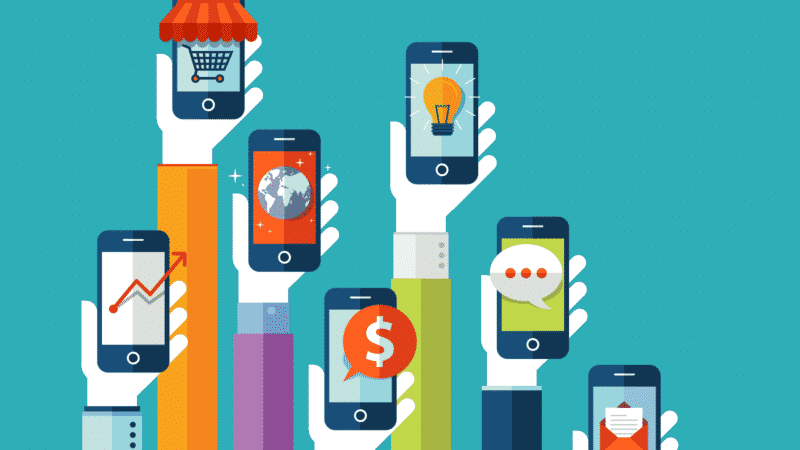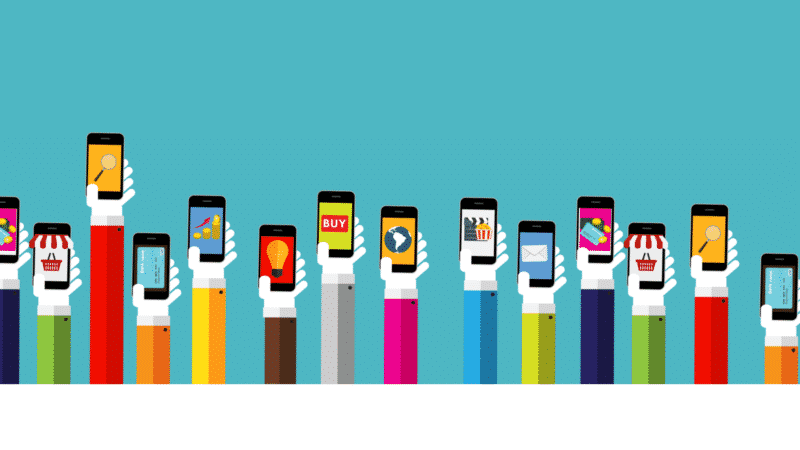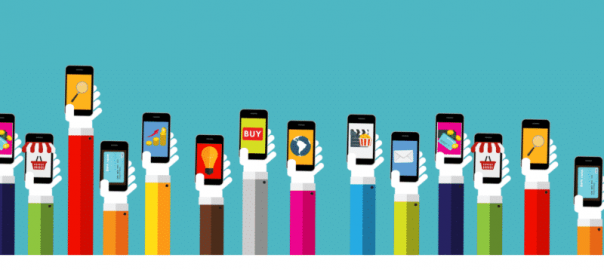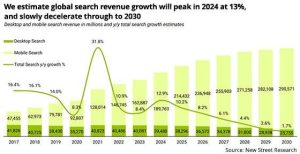The tactics, technologies and strategies you need to connect with customers where they are — their smartphones.
Mobile marketing allows marketers to meet their customers where they are, which today is the default. The advent of mobile technologies like 5G is also allowing marketers to deliver, or conceive of experiences, that augment the experience. Mobile is a key component of cross-channel campaigns (TV, OOH, Print). Mobile also offers the possibility of precision location marketing for even better personalization.
Mobile marketing covers a wide variety of digital marketing tactics, technology, and strategies that focus on reaching people on their mobile devices (but mostly their smartphones). Mobile marketing is important because nearly 84% of the global population owns a smartphone. That’s 6.6 billion people.
The mobile web is also getting transformatively faster, with 5G quickly becoming the global wireless standard. 5G enables consumers to comfortably stream movies, connect to multiple devices, and makes mobile browsing comparable to desktop/laptop browsing.
In short, if you’re doing just about anything online, you’re already reaching mobile consumers. Mobile access to the web is ubiquitous. By posting content to social media platforms, optimising your website for Google, paying for digital ads, and using a mobile-friendly platform to build and manage your website, you’re participating in the mobile zeitgeist.
But for mobile marketing to be effective, it needs to be strategic. This space is changing constantly. Understanding the basics is critical to the successful planning and execution of a mobile marketing campaign.
In this post, we’ll cover mobile marketing 101—what it is, why it’s important, and how marketing teams can accomplish it successfully.
Key points covered include:
- What is mobile marketing?
- Popular mobile marketing techniques.
- Why marketers should care about mobile marketing.
- Tools and software that enable mobile marketing.
- Who uses or works with mobile marketing tools?
- Tips to get the best out of mobile campaigns.
- How mobile marketing can help you succeed.

What is mobile marketing?
Mobile marketing involves creating marketing campaigns that specifically target consumers on mobile devices. As a component of digital marketing, mobile marketing employs many of the same tactics, but many mobile marketing approaches leverage the unique properties of mobile devices, particularly smartphones.
There are two primary ways mobile users get marketing messages and other content—over a cellular connection with 4G/5G technology or via a wireless internet connection (Wi-Fi). The latter method can include data charges, though most major mobile carriers offer the option of unlimited data plans. Mobile users can also connect their phones to Wi-Fi using Bluetooth tethering which allows devices to share an internet connection.
The mobile marketing ecosystem includes ads on mobile websites and apps but goes beyond the traditional digital marketing paradigms to exploit mobile-centric features like SMS, MMS, and proximity targeting. Below, we summarize the most common mobile marketing approaches.
7 common mobile marketing techniques:
Short message service (SMS) marketing
SMS marketing is a text messaging strategy where businesses send text messages to customers on their mobile devices over a cellular network. Messages can be promotional, service-based, or transactional. For example, a local hair stylist might send information to their customers about a new service they’re rolling out, appointment reminders, or a request for feedback based on a recent visit.
SMS can also be used by retailers to facilitate payments. Customers pay from their cellular-enabled device via text using technology like Podium Payments, a secure payment processing platform that facilitates text-to-pay transactions.
Multimedia messaging service (MMS)
As with SMS marketing, MMS marketing also uses a cellular network to send messages, but it includes multimedia content like images, video, and audio. MMS content is typically longer than SMS content (MMS can be up to 1600 characters versus 160 for SMS). Data charges can drive the cost of MMS marketing up since multimedia messages, by design, involve file attachments. They can also cost the consumer more money if they don’t have an unlimited texting plan.
Mobile app marketing
People love their mobile apps. eMarketer estimates that US adults spend about 90% of their mobile usage time with apps versus mobile browsers. Display ads in apps manifest as image ads (e.g., banners), video newsfeed ads on social apps, Stories ads (which can include images, video, text, and interactive features,) and multimedia ads that interrupt you in the middle of your favorite mobile game.
Location-based marketing
Location-based marketing delivers promotional messages to a consumer’s mobile device based on their past-or-present location. Location-based tactics like geofencing use a device’s GPS to determine a customer’s location in real time, then serve in-the-moment ads or content.
The latter tactic involves targeting customers who are near a competitor’s physical location. The most infamous example of this is when Burger King’s app targeted people within a few hundred feet of a McDonald’s location, giving the lucky app users a coupon for a one-penny Whopper.
Proximity (beacon) marketing
This is a mobile marketing tactic that uses beacons—small devices that transmit Bluetooth signals—to trigger ads, content, or alerts on a user’s smartphone. Beacons are physical gadgets tucked in unobtrusive places (e.g, behind walls, beneath shelves, within light fixtures, etc.)
Let’s say, for example, that you have a coupon app installed on your phone and you walk past a store with an active sale. The app will send you an alert to let you know Store X is having a sale and you should drop in. There are several different beacon protocols including iBeacon for iOs users and Eddystone for Android.
Voice marketing
Voice marketing uses voice-enabled devices like smart speakers and voice assistants on mobile phones to market to your audience. It’s mobile marketing in the sense that it relies heavily on smartphone usage. (140 million adults in the US use voice assistants on their phones, according to data from Voicebot.ai.)
It’s also largely screenless, relying on audio versus visual elements to interact with customers. Voice marketing tactics include things like voice search optimization which helps surface content to people using voice assistants, voice-activated ordering à la Starbucks, and letting customers book a hotel room via their smart speaker.
Quick-response barcodes
Quick-response (QR) barcodes are two-dimensional barcodes that can be scanned by mobile devices to access information or services. Although QR codes are associated with mobile marketing, they’re an effective way to engage customers across many offline and online channels.
QR codes can be added to digital, video, and print ads to motivate customers to interact with a brand. For example, a retailer could connect a coupon to a QR code in a TV ad with the goal of motivating viewers to scan the code (and make a purchase using the coupon).

Why marketers should care about mobile marketing
Mobile marketing allows marketers to engage with their customers wherever they are—literally. The advent of mobile technologies like 5G also allows marketers to deliver, or conceive of, experiences that augment the physical environment.
This is an incredibly immersive way to engage with consumers. For example, clothing retailer ASOS used augmented reality to digitally fit hundreds of designs onto models during the pandemic, successfully avoiding in-person fashion shows.
Mobile is a key component of cross-channel campaigns (TV, OOH, Print) and offers the possibility of precision location marketing for even better personalization.
One of the great things about mobile marketing is that it allows businesses to reach a wide audience. People use their mobile devices all the time in just about every situation.
Here are some more compelling reasons why you should care about mobile marketing:
- There are nearly 15 billion mobile devices in the world and that number is expected to reach over 18 billion by 2025.
- At the start of 2021, 97% of Americans owned a cell phone of some kind, with 85% owning a smartphone, up from 35% in 2011, according to a Pew Research Center report.
- Smartphone penetration is high across all ages and demographics. The devices are owned by 90% of US adults between 18 and 49, 83% of people between 50 and 64, and 61% of people 65 and over, according to the same Pew report.
Who uses or works with mobile marketing tools?
Mobile marketing falls within the ecosystem of digital marketing. As such, it’s primarily marketers who use the tools involved with running mobile campaigns. This is a relatively new technology that’s been gaining traction in the last few years as mobile devices become more widespread.
Retailers, grocery chains, restaurants, and travel/hospitality businesses are all using mobile technologies to transform the way they market to and interact with customers.
Marketers need to stay particularly vigilant about the new developments in mobile technology so they remain competitive and understand how consumers use mobile devices (e.g., voice assistants for scheduling appointments, retail apps for curbside pickup at physical stores, etc.)
As with any other digital strategy, mobile campaigns require planning, tracking, analysis, and reporting. However, there are a few extra steps involved in mobile campaigns due to the unique nature of mobile devices. Here are some things to consider to get the best out of mobile campaigns.
- Keep your mobile ads short and sweet. Concise copy is key on a tiny screen.
- Get personal with SMS marketing. Texting feels more intimate than other forms of communication, so take advantage of that closeness to forge relationships with your customers.
- Think outside the banner. Reimagine what a mobile ad can be and break out of the traditional banner format to stand out on small screens.
- Go local with geo-targeting. Mobile users are often searching for nearby businesses, so make sure your location services are up to scratch.
- Use push notifications sparingly. No one likes to be bombarded with messages. Only send push notifications when you have something relevant (and interesting) to say.
What types of tools or software enable mobile marketing?
Mobile marketing software provides a wide range of capabilities for businesses looking to reach their mobile customers. These tools can be purchased as stand-alone technology or integrated with more advanced digital advertising platforms.
Commonly used mobile marketing software:
- Mobile-focused platforms: Mobile advertising tools like AdMob and SMS marketing platforms like SlickText allow businesses to reach mobile users with targeted ads and messages.
- Social media management software: Tools like SproutSocial and Hootsuite help businesses keep track of their mobile customer base and interact with them through mobile-friendly platforms like Facebook and Twitter.
- Loyalty program technology: In-app rewards programs give mobile users an incentive to keep using a particular app, keep shopping at a particular store, and refer friends and family to a business. Mobile push notifications built into loyalty apps alert customers about offers, content, and product updates.
- Marketing automation platforms and tools: Marketing automation platforms like Adobe Marketing Cloud and SharpSpring often have mobile marketing features built in. These include the ability to create mobile-focused ads, retarget mobile users, and track and analyze customer behavior on mobile devices.
Many mobile marketing tools can be used together to create a comprehensive mobile marketing strategy, allowing businesses to provide a seamless customer experience across all channels. By reaching mobile customers through multiple channels and offering them valuable rewards, businesses can build long-term relationships with their mobile target audience.

How mobile marketing can help marketers succeed
We live in a mobile-first world where an increasing number of businesses are turning to mobile marketing to engage with existing customers and reach a wider audience. And it’s no wonder—mobile marketing offers several key advantages to traditional digital marketing, especially when it comes to reaching younger consumers like millennials and gen z.
Mobile marketing can also be more effective than traditional digital campaigns in countries that rely more on phones than computers for internet access. If you’re looking for a way to reach a larger audience and grow your business, mobile marketing is worth considering.
The post Why we care about mobile marketing: A guide for marketers appeared first on MarTech.
(13)








